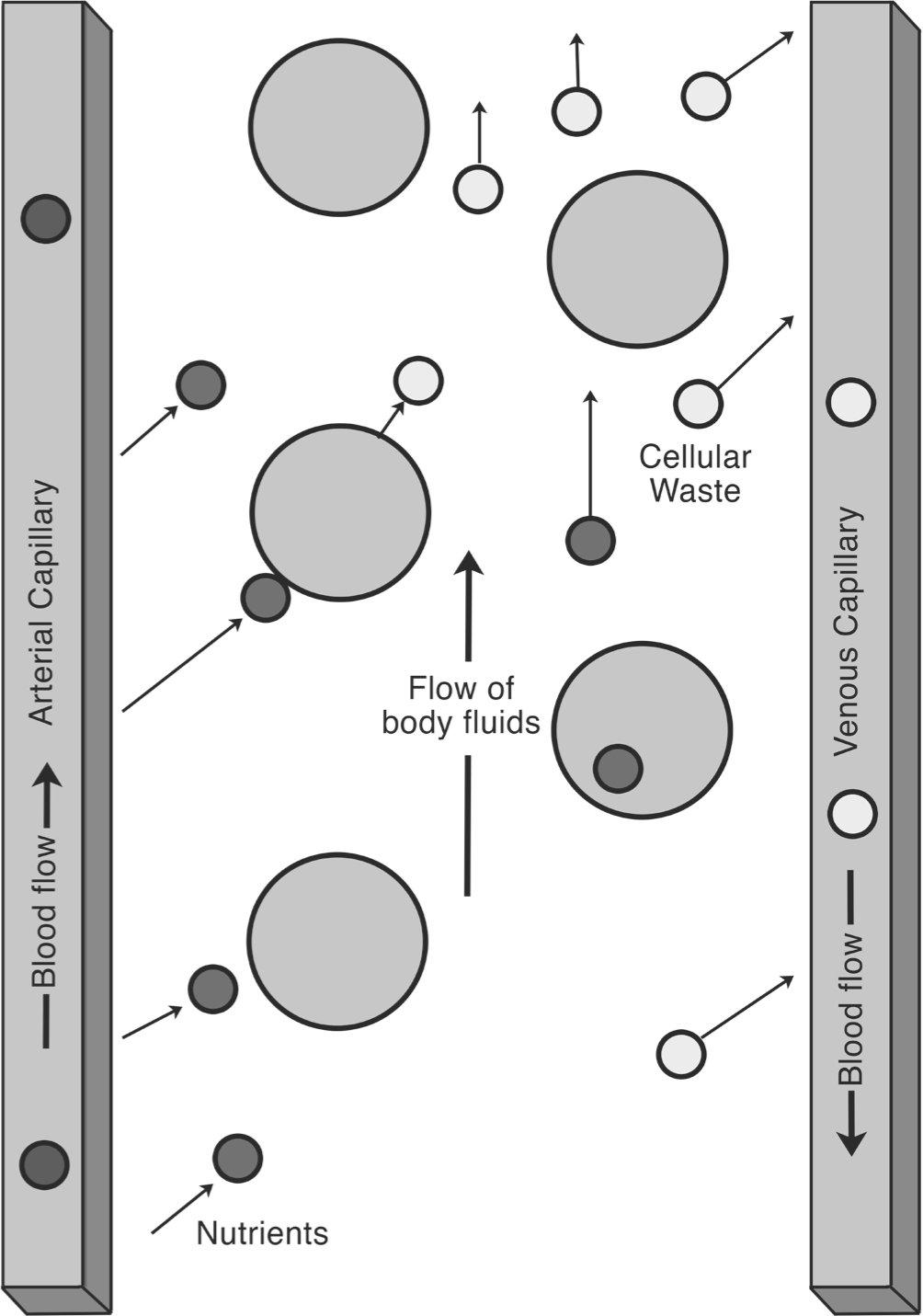Before discussing the self-healing system in more detail, it is important to explain Traditional Chinese Medicine’s (TCM’s) concept of how the human body works. TCM views the entire body as a complete system and the organs as all closely linked with one another. None of the organs works in isolation, and they are never viewed in isolation in Chinese diagnostics. Indeed, the TCM diagnostic approach is based upon the various ways in which organs influence one another.
The human body has far too many organs for each and every one, and their relations with one another, to be analysed individually. A way to illustrate this problem is to imagine that your body consists only of your heart and eyes. The number of links you can draw between your organs is just one. If then you have lungs as well, there would be a link between the heart and the lungs, the lungs and the eyes, and the heart and the eyes: a total of three links. As we add the brain, ears, nose, mouth, hands, feet, skin, hair, large intestine, small intestine, and so on, the number of links increases exponentially (see Figure 3.1) and becomes impossible to analyse.
Qigong is a meditation technique that has existed in China for thousands of years. The main purpose of the practice is to cultivate and channel Qi (energy). Practitioners of Qigong long ago discovered that Qi flows along particular paths inside the human body, known as meridians. Qi is energy that the body is equipped with from birth. While TCM practitioners are trained to measure Qi, modern technology is even now incapable of detecting it. However, as I describe in the Appendix (page 121), equipment has been developed that can detect Qi and measure its fluctuations in real time. It is possible that in the near future, these technologies could be used to prove the existence of Qi at a scientific level.
Qigong practitioners charted these Qi flows and created the meridian charts that exist today. In South America, back in ancient times, the Incan shamans made a similar chart. The two civilisations were in opposite parts of the world, tens of thousands of miles apart, yet they created charts that were almost identical.
Through a long period of experimentation, the individual meridian points were categorised into sections (meridian lines), with each section linked to the corresponding organ(s) that it influenced. The 14 resulting main meridians include 12 paired meridians and two single meridians. The 12 paired meridians correspond to 12 different organs, with the two single meridians being the front and back centre lines of the body from top to bottom (called the Governing Vessel and the Conception Vessel).
Qigong practitioners also found a strong correlation between discomforts in particular organs and the clogging of flow in their respective meridians. Using certain Qigong techniques, the meridians could be unclogged by focusing on the affected meridian points, and this in turn resolved the discomfort in the corresponding organs.
From a design perspective, meridians can be viewed as pathways for bodily maintenance. When the body’s organs are not functioning optimally, signals are sent from the meridian points, causing pain. Our instinctive reaction when the signal reaches the brain is to rub or lightly tap the meridian point that is hurting. This helps to unclog the meridian point, improving the functioning of the corresponding organ in the process.
Not all organs have corresponding meridian points. This leads to the important categorisation of organs with and organs without meridian points. Organs with meridian points are those that need to be directly treated, whereas organs without meridian points do not. When an organ without any meridian points malfunctions, the malfunction may not arise from that organ itself. The real cause of the discomfort may lie in the 12 organs with meridians. It is these that should therefore be treated.
For example, the skin has no corresponding meridian. Dry skin can cause a variety of discomforts and illnesses. TCM believes the primary cause of dry skin lies in the body’s inability to distribute water efficiently to the entire body. Therefore, the lungs, which are responsible for water distribution, are likely to be the cause of the discomfort or illness. To cure problems of the skin, the lungs need to be treated first.
System simplification
The first step to system simplification reduces all the body’s organs to 12 meridians, as I have described. The second step is to observe the relationships between the 12 meridians: the heart, small intestine, liver, gallbladder, spleen, stomach, lungs, large intestine, kidney, bladder, pericardium, and Sanjiao (thoracic cavity). As I have said, TCM views the human body as a complete system; there are close ties between each organ. In other words, the entire body system can be simplified into 12 sub-systems – the 12 main meridians. By understanding the relationship between them, we can construct a system of logic for how the body communicates and deals with illnesses, as well as finding solutions and treatments for those illnesses.
Figure 3.1 illustrates the 12 main meridians, and the 66 links that can be drawn between them. Understanding all 66 is a tedious and difficult task, so to be useful the system must be further simplified.
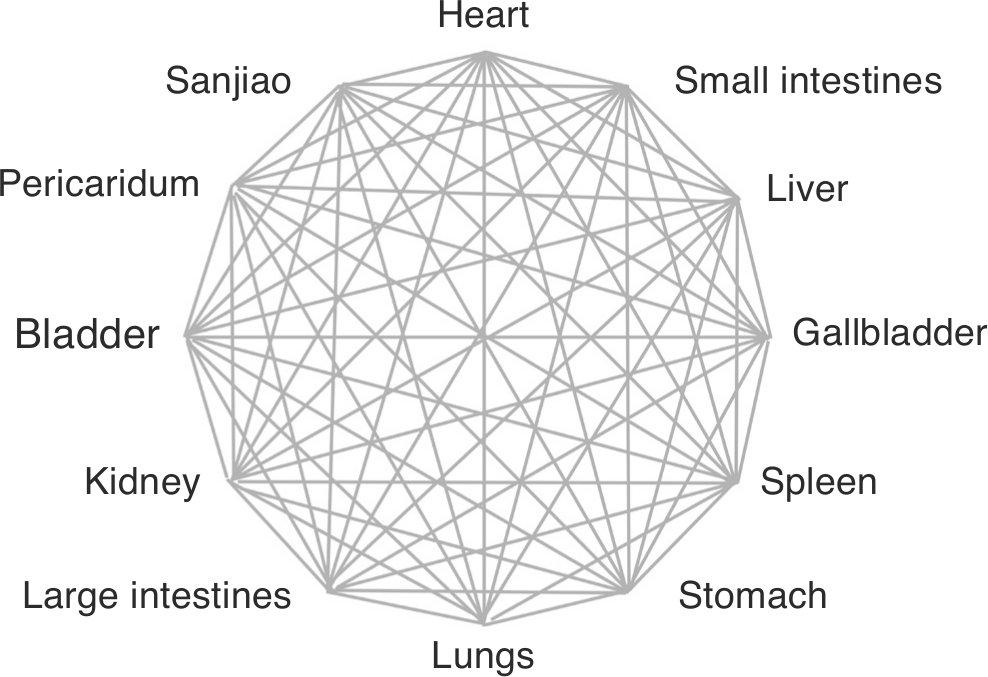
Figure 3.1: The 66 relationships between the 12 meridians
By examining the location of the meridians, we can see that there are six that travel along the arms (heart, small intestine, lungs, large intestine, pericardium, and Sanjiao (thoracic cavity)) and six that travel along the legs (liver, gallbladder, spleen, stomach, kidney and bladder). Out of the six meridians that travel along the arms, we can see that three travel along the inner side of the arms and three along the outer. The locations of the inner and outer meridians correspond to one another, forming three pairs of meridians: those for the heart and small intestine, lungs and large intestine, pericardium and Sanjiao (thoracic cavity). The same pairings can be made for the meridians that travel along the legs: liver and gallbladder, kidney and bladder, spleen and stomach.
The pericardium and Sanjiao meridians are in charge of the body’s Blood and Qi, respectively. The pericardium influences Blood flow, while the thoracic cavity (Sanjiao) meridian influences the flow of Qi. These two meridians are considered to make up the body’s energy control system, and they can be looked at separately from the other main meridian sub-systems for now. That leaves 10 sub-systems.
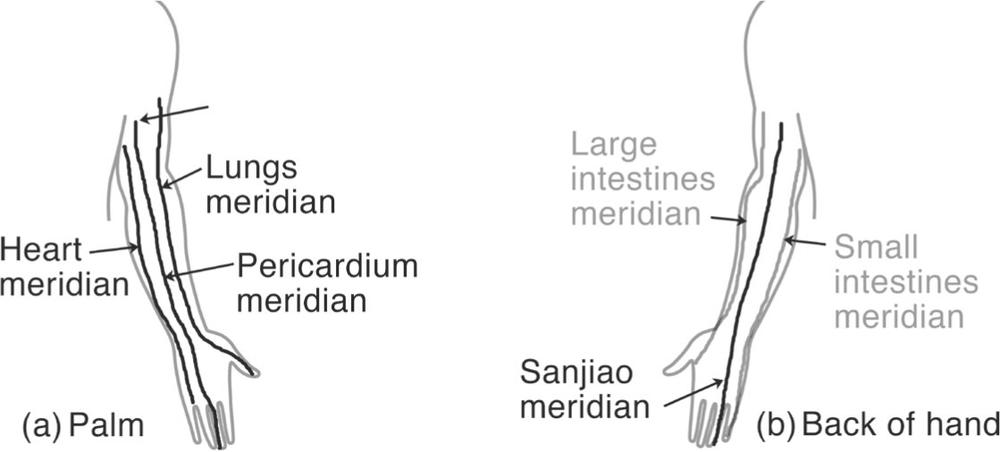
Figure 3.2: The meridians in the arms – (a) heart, lung and pericardium meridians; (b) large intestine, small intestine and Sanjiao meridians
Figure 3.2 (a) shows the palm-side view of the left arm. It contains the heart, lung and pericardium meridians. The lung meridian reflects the lungs, and is closely tied to their performance. Massaging the lung meridian can improve the performance of the lungs. Likewise, the heart and pericardium meridians influence the performance of their respective organs. Massaging them can also have a positive effect. The right arm and hand have the same set of meridians. The arms have identical sets of six meridians, while the legs have the remaining, and again identical, sets of six meridians. The left and right sides of the body have symmetric meridian structures.
Figure 3.2(b) shows the backhand view of the left arm. It contains the small intestine, large intestine and Sanjiao meridians. As with the three on the palm-side, the small and large intestine meridians influence their respective organs. Massaging them improves their respective performance. The Sanjiao meridian influences the thoracic cavity, and when massaged, improves the flow of Qi in the chest area. This is often used to relieve discomfort in the torso.
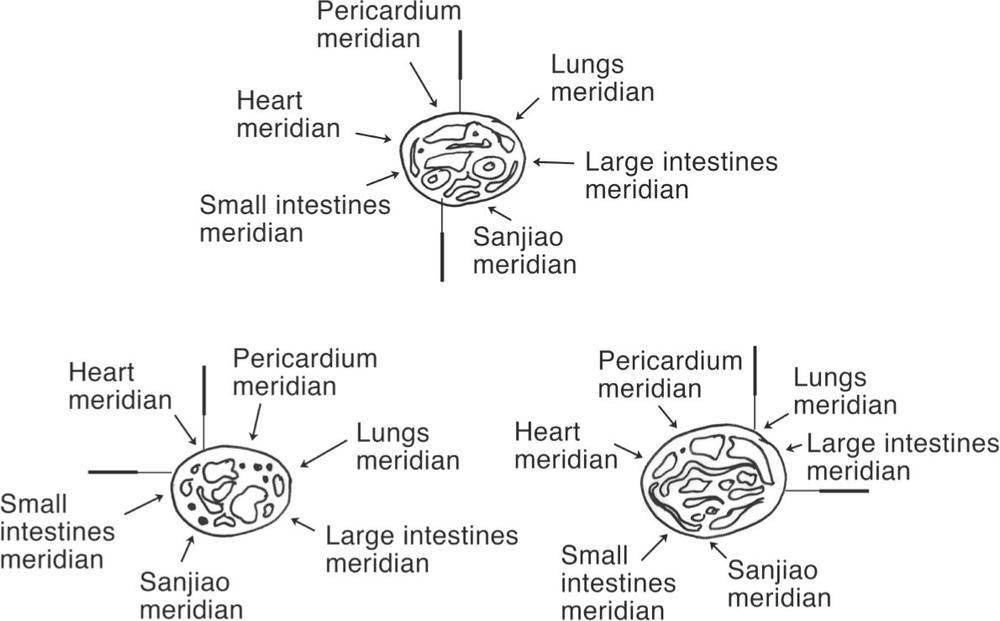
Figure 3.3: Cross sections through the arm showing the relative positions of the acupuncture sites: (a) heart and small intestine; (b) pericardium and Sanjiao; (c) lungs and large intestine.
Figure 3.3 shows three cross-sections through the arm. From the first (a) we can see that when acupuncture needles are inserted into the heart and small intestine meridians, the tips of the needles are very close together. The second cross-section (b) shows how the pericardium and Sanjiao meridians correspond. The third (c) concerns the lung and large intestine meridians.
We should note that these pairings have great importance in TCM diagnostics. As people have discovered over time through extensive clinical experience, illnesses that affect one meridian will have direct influence on the meridian with which it is paired. An example of this would be a patient suffering from the common cold. In TCM, the common cold is described as cold energy attacking the lung system. During a cold, patients will often experience constipation or diarrhoea, demonstrating how the lungs and large intestine influence one another.
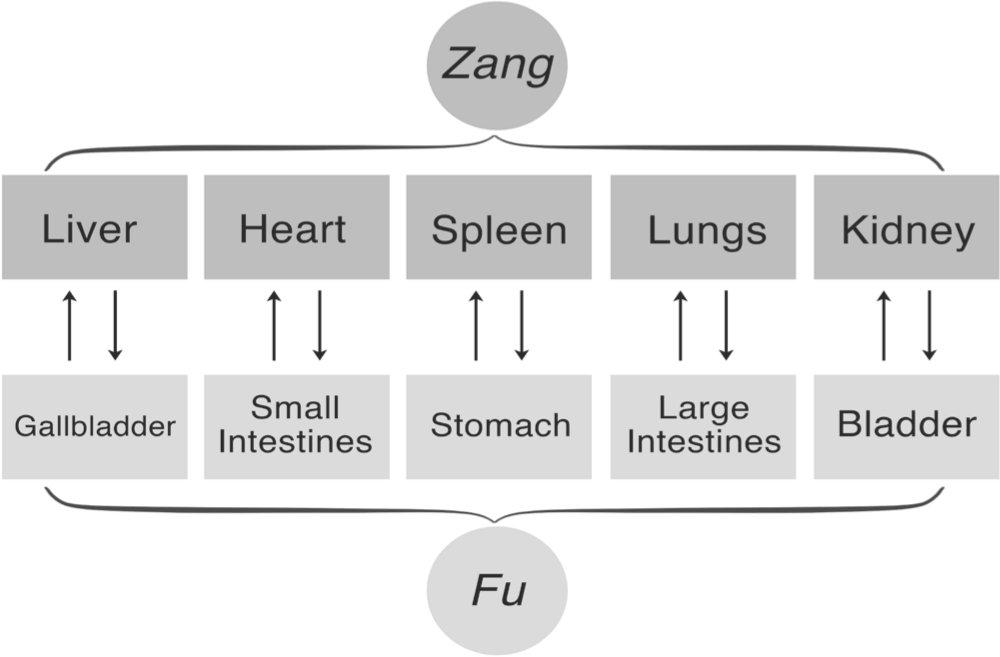
Figure 3.4: The 10 body sub-systems (aside from the pericardium and Sanjiao) designated Zang or Fu and how these interrelate.
Further useful simplification can then be made by using the concepts of Zang and Fu which categorise the 10 body sub-systems. An interesting observation about Zang and Fu concerns the physical makeup of the organs to which they relate. All of the organs designated as Zang have a complex internal structures: the heart, liver, kidneys, spleen, lungs, and pericardium. The organs designated as Fu, on the other hand, have a hollow interior: the small intestine, gallbladder, bladder, stomach, large intestine, and Sanjiao (thoracic cavity).
When the 10 sub-systems are split into Zang and Fu, we are left with five Zang and five Fu. Each Zang organ fluctuates together with its corresponding Fu organ, and the two together can be viewed as one sub-system. In this way, 10 sub-systems are simplified down to five. The 66 system links are thus reduced to only five (see Figure 3.4), facilitating the use of the traditional Five Elements (wood, fire, earth, metal and water) Theory diagnosis.
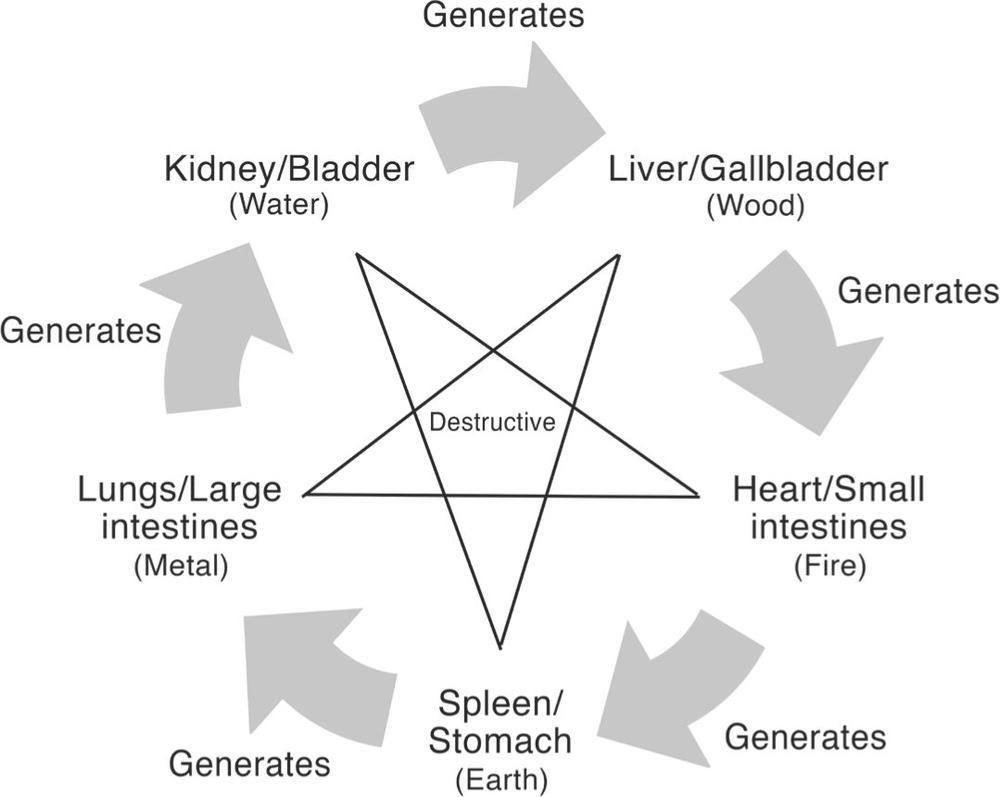
Figure 3.5: How the five sub-systems and the elements to which they relate affect one another positively (arrows) and negatively (star).
To recap, starting with numerous organs, TCM simplifies them into 12 main meridians. Pairing the five Zang and five Fu meridians, while keeping the two meridians for Blood and Qi separate (as these are not systems or organs per se), reduces those to five sub-systems. The relationships between the five sub-systems can then be summarised as shown in Figure 3.5.
Traditionally each sub-system has been associated with one of the five elements which relate the state of the human body to the natural environment: liver–gallbladder with wood; heart–small intestines with fire; spleen–stomach with earth; lung–large intestines with metal; kidney–bladder with water. (It is important to note that it is not the five elements themselves that are significant – they were used in ancient times as a memorisation tool that related to known entities; it is the relationships between the organs that have been observed over time and thereby organised into a system that are important.) When a negative effect occurs in one of the elements, it will cause a negative effect in a corresponding element. Wood will affect earth, earth will affect water, water will affect fire, fire will affect metal, metal will affect wood, which will affect earth, and so the cycle continues. For example, when a negative effect occurs in the liver, which is represented by the element wood, it can cause a negative effect in the stomach, represented by the element earth.
There is today an epidemic of chronic disease of unknown cause. Not having a systematic approach to understanding the logic of the human body may be the primary factor contributing to this lack of knowledge. Having a system for understanding the relationships between the organs gives a greater chance of understanding the bigger picture of what the body is trying to do to achieve self-healing when it experiences abnormalities. From that systematic perspective, TCM’s diagnostic system is philosophically ahead of modern medicine by 3000 years.
In ancient times, human inventions were few and simple. For the vast majority of the population, having systematic understanding of a field was rare. The Five Elements Theory was regarded as a form of metaphysics, and was something that very few people could understand. With electronic technology being so widespread now, most people have some concept of how systems work. The details of the Five Elements Theory no longer need to be memorised using the names of the elements, but can be understood logically and without mysticism. The theory is no different from early physics models before they were proven through rigorous testing, and it requires dedication from a large group of scientists to undertake the task of testing the TCM model. In an age where chronic diseases are rampant, that research direction might be worth a try as opposed to the reverse-engineering-based direction of modern medicine; and it might give us a better shot at uncovering the truth about the human body and developing true cures for chronic illnesses.
The meridian is the passageway for human body fluid
The body’s meridians are thought to have several different functions, one of which is as passageways for body fluid (‘lymph’ in modern medicine). This concept was originally suggested by Chinese and Japanese researchers in the ‘Body Fluid Passages of the Meridians Theory’. I have used those findings to create a household massage method which is explained in Chapter 6 and a related video. In the past several years, I have employed this method to help family and friends overcome their chronic illnesses. The method is easy to execute, as it does not require precision in targeting specific meridian points. You just have to work around the area of the meridian points for it to be effective. This makes it highly suitable for those without any expertise in massage to try at home.
As I have said, this massage method arose from the idea that ‘the meridian is the passageway for human body fluid’ and it works differently from most massage methods that aim to reduce stress in the muscles. The goal here is to increase the flow of the body’s interior fluid, which in turn increases the functionality of the body. From a TCM perspective, fluidity of the meridians increases the functionality of the corresponding organs. Therefore, raising the effectiveness of corresponding organs is the purpose of this massage treatment. By improving the organ systems corresponding to the meridians, the body’s state of health will naturally improve.
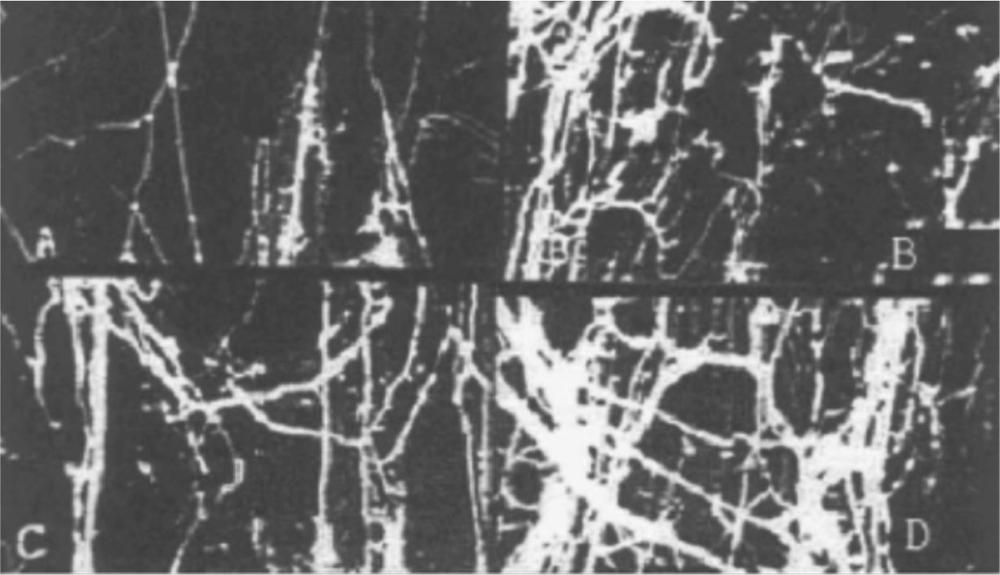
Figure 3.6: The random arrangement of capillaries at sites that are not near meridian points
According to Shanghai Fudan University’s Professor Fei Lun and his team’s research, while human capillaries appear to be randomly patterned throughout the body (Figure 3.6), those that are close to meridian points appear to run parallel to the meridians (Figure 3.7). Professor Lun’s team discovered that this phenomenon, along with differences in blood pressure between meridian points along the same meridian, suggests that there is a flow passage between the meridian points where body fluid travels from meridian point to meridian point. In this scenario, the body fluid does not travel inside any blood vessel or capillary but rather within a flow passage located outside the blood vessels.
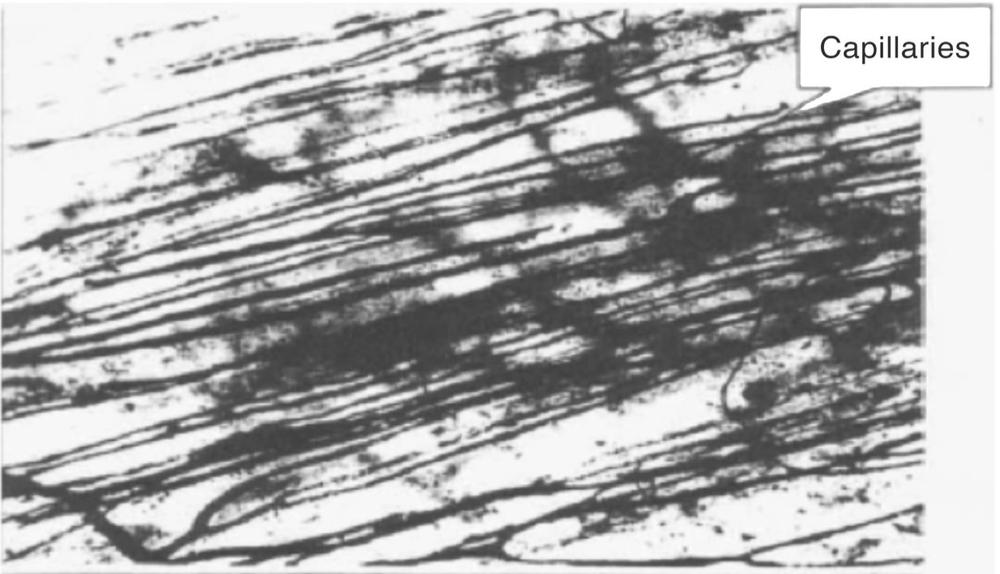
Figure 3.7: Capillaries running parallel to the meridians near meridian points
In Professor Fei Lun’s experiment, micro-radioactive material was injected into certain parts of the body through which meridians are known to pass, to observe the movement of such material within the meridian. The experiment showed that the radioactive material did indeed move along the meridian path, which provides evidence in support of the theory that the meridian system is a series of body fluid flow passages that cover most of our body.
These passages serve a similar purpose to blood vessels and veins – to carry nutrients to and remove waste from body cells, as a backup system for blood vessels in the transferring of nutrients and wastes. The majority of our body cells are surrounded by body fluid. Nutrients travel from blood vessels to the smaller capillaries and are then eventually excreted from the capillary walls in body fluid (Figure 3.8). Body cells absorb nutrients within the body fluid and the process reverses for cell waste. The efficiency of the process of providing nutrients and removing wastes depends on the fluidity of these flow passages. Any reduction in the fluidity of meridians due to various pathogenic factors may lead to a variety of illnesses, including eczema, lupus, obesity, asthma and hair loss. These illnesses are caused by the body’s inability to remove waste properly from the meridians, which is why improving meridian fluidity is one of the most important elements of any TCM healing process.
But how do we improve meridian fluidity? As we have seen, there are 12 main meridians and an assortment of minor meridians that run through our entire body. To improve the fluidity of all the meridians would be a very difficult task. Thus, we need to develop a method that is easy and effective.
In TCM, the bladder meridian is considered to be the main meridian that governs the removal of waste. It contains specific meridian points that correspond to all 12 meridians. We can imagine the bladder meridian as the main sewage system of the human body that gathers the cell waste from the other 11. The waste is transported to the kidneys and then to the bladder, where it is removed via urination. By improving the fluidity of the bladder meridian, we can improve the waste removal process as a whole, leading to the improvement of fluidity for all meridians.
This type of body fluid circulation is similar to ocean currents or wind drafts – we can observe ocean currents as along as the Earth is rotating. Flow through the meridians is active only while a person is alive – once movement and life stop, the current stops also. Dissection subjects have already lost their blood pressure, so all the body fluid has stopped moving. With our current technology, we are incapable of producing equipment that can monitor body fluid movement in a living person.
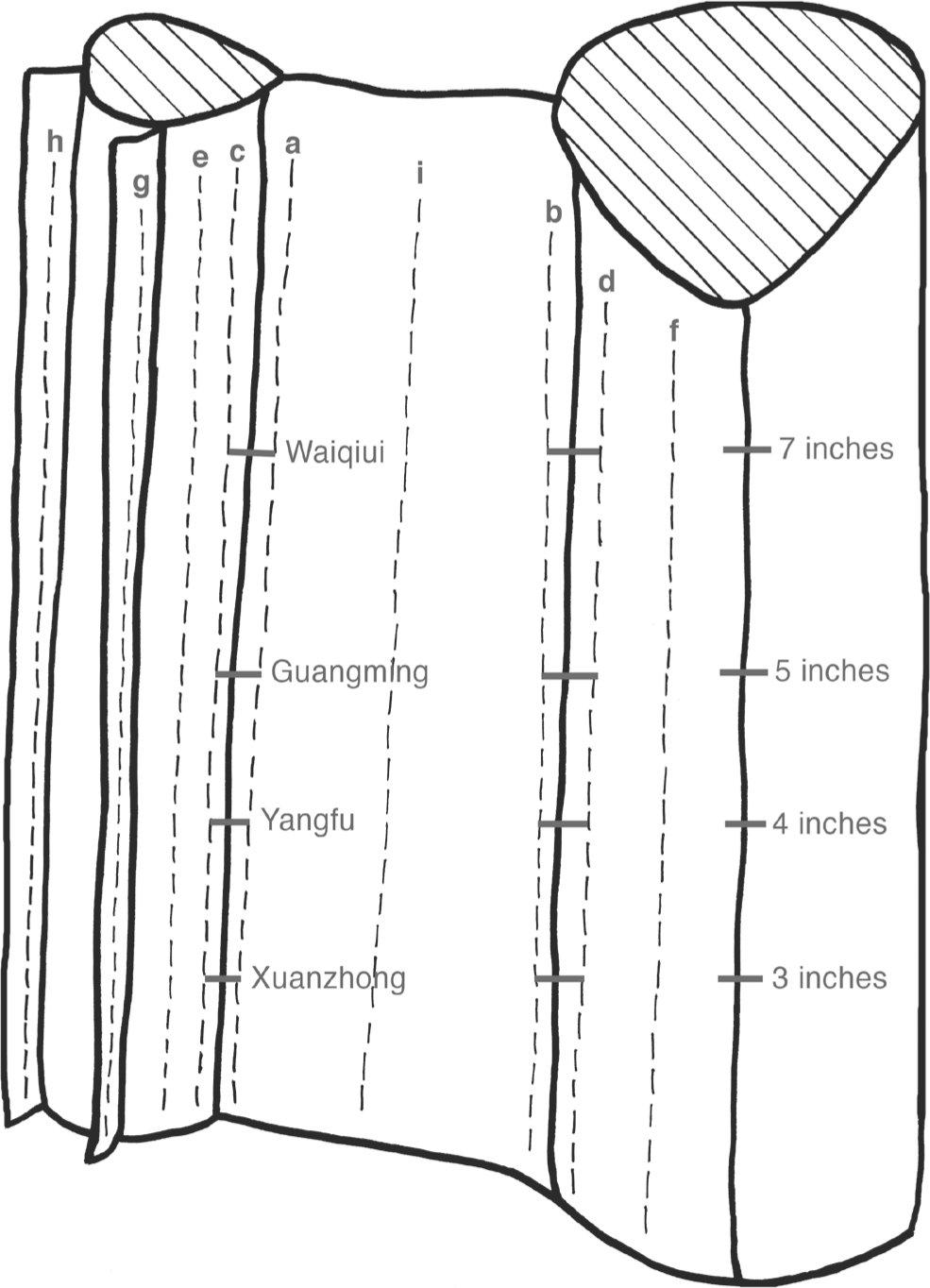
Figure 3.9: Corresponding meridian points on the gallbladder and stomach meridians – they occur at the same height on different meridians
Therefore, this body fluid model remains a theory, and while it can be mathematically calculated it cannot at the moment be seen.
The body’s meridians run vertically – some from hands to head, some from head to feet, and some from feet to torso. The main passageways for body fluid within the meridians are between the bones and the periosteum (the membrane surrounding the bones). Therefore, most meridians are arranged along the bones. Another interesting phenomenon concerning meridian lines is that most points seem to be at the same height as their respective points on other meridian lines (Figure 3.9). If we link together the points of equal height, we end up with horizontal passages that circulate around the torso and the back, ending up at the bladder meridian.
This may mean that cellular waste material exits through one of two passageways. The first is through the veins and into the blood. It is circulated through the liver and spleen, which filter waste from the body. The other is through meridian flow, into the bladder meridian, and the bladder expels it from the body.
As I have explained, using the above logic, I have developed a series of massage techniques to improve the fluidity of the meridians; one is intended to improve the fluidity of the bladder meridian specifically (see page 103). These massage techniques are described in Chapter 6. By practising these techniques on a regular basis, significant improvements can be achieved in various chronic conditions.
The self-healing system
When following Traditional Chinese Medicine’s methodology to treat chronic diseases, the main objective is to use any means available to improve the body’s self-healing system, and to let it deal with the chronic condition itself. In other words, from a TCM perspective, the real doctor that deals with chronic diseases is the body’s own self-healing system. The exterior doctor can act only as an assistant. Modern medicine, on the other hand, ignores the body’s ability to handle problems. All chronic disease treatments are handled solely by doctors.
From my experience as an R&D engineer, when we are designing a more complicated product, maintenance is something that must be considered. A laptop, for instance, must have an opening at the back, and at the same time there must be easy consumer access for maintenance. Without these, it is very difficult for a product to have a decent life expectancy.
The human body is a product that can be used for decades, if not a full century. From a design perspective, it is far more complex and perfect than any man-made piece of machinery. To be able to last so long, it must have a near-perfect self-healing system that even as long ago as prehistoric times could last for several decades provided the person was not attacked and had enough nutritious food.
Even though the body has strong self-healing mechanisms built in to it, it may still exhibit illness from time to time. The main reason could be that the body’s overall energy is too low, causing the self-healing system to malfunction. Alternatively, the symptoms could just be the effects of whatever processes the self-healing system needs to undergo.
Due to modern medicine’s current inability to measure the body’s total energy and TCM’s lack of objective equipment to do so, the energy level of the patient can be determined only by observation. For example, with Asians in general, skin colour and texture are good indicators. TCM believes that a newborn baby has high levels of Blood and Qi. Older people have lower levels. So the closer a person’s skin condition is to that of a baby, the higher the total energy level is thought to be. A baby’s skin is soft and fresh. An older person’s skin is dry and dim. Some may ask, ‘But what if you have tanned skin?’ The answer to this is in the texture. Tanned, healthy-looking skin has a smoother texture, whereas unhealthy skin is comparatively dry, rough and wrinkly.
Another telling indicator is the colour of the lips. A baby’s lips are closer to pink, while an older person’s are darker. There are other useful pointers, such as the state of the hair and eyes. These are all markers that TCM practitioners look for.
After a TCM practitioner has determined the patient’s energy level, the patient will be asked about possible lifestyle changes that may have occurred prior to the emergence of symptoms. From that information, the trend in the patient’s overall health is determined: upwards or downwards. From this it can be deduced whether the patient’s body is suffering from an illness, or whether it is just undergoing maintenance. A decision about treatment can then be made.
The itching and swelling symptoms of a cut are part of a normal healing process. Because these symptoms happen on the outside, have short recovery cycles, and are fairly common, we readily understand that they are not part of an illness, but simply bodily maintenance at work. When the body is maintaining the organs, it is logical to think that there may also be uncomfortable symptoms. These uncomfortable symptoms, due to the fact that they are not on the surface and are therefore difficult to observe, may well be mistakenly classified as diseases. This misinterpretation stems from modern medicine’s limited understanding of the self-healing system.
Raising the effectiveness of the body’s self-healing system is one of the fundamental goals of TCM. Some treatments focus on reducing the symptoms caused by the self-healing system. TCM calls this ‘tackling a problem on the surface’. Some treatments focus on raising the body’s total energy level, which increases the efficiency and capabilities of the self-healing system, ultimately letting the body solve problematic illnesses by itself. TCM calls this ‘dealing with the root of the problem’.
The logic of self-healing
Self-healing is an observable ability of the human body that we often overlook. We know that it plays a critical part in both internal and external injuries, since that is well known and documented. However, this is just the tip of the iceberg. Every part of our body is constantly in the process of breaking down. Using the analogy of the body as a computer, every time you use the computer, you are wearing it down little by little. Using it incorrectly only increases the amount of wear and tear. Similarly, the body also suffers daily wear and tear. The system that tries to minimise that problem and prolong the body’s lifetime is the self-healing system.
When it comes to self-healing, TCM asserts that the body ‘thinks’ in terms of cost-benefit analysis. It asks itself questions such as: ‘If I expend 100 units of energy on organ A, will that benefit be more than expending 100 units of energy on organ B?’ If this were the only level of decision making, it would be obvious and unworthy of further discussion. But TCM goes a couple of steps further, asserting that the self-healing system can analyse the body’s current situation, both internally and externally, and make complex and precise decisions about when and how to go about maintaining the organs.
A quick example to illustrate this process is how the body deals with psoriasis. From a TCM point of view, psoriasis is the equivalent of a car crash that has blocked an entire highway. The body recognises that there are damaged or unusable body tissues underneath the skin that need to be got rid of. It analyses possible exit routes and finds that the meridians are blocked; it would take far too much effort to transport all of the bodily debris through the blood so the solution it eventually arrives at is to remove the debris through the skin – this is the shortest distance and the most efficient approach. It then uses what energy it has to move the debris through the skin. When this process is complete, the body is rid of the debris, allowing better fluidity and functionality. (Of course, if the meridians for removing waste from under the skin remain blocked, there will be a continuous supply of debris to be cleared through the skin.)
Research papers on the body’s self-healing system are few and scattered. Western research topics focus only on individual case studies of the self-healing system miraculously overcoming particular hard-to-cure diseases, without any systematic theories that try to explain the phenomenon. This is in large part due to the tremendous complexity of the human self-healing system and the fact that our current scientific approaches are not yet at a level where we can quantitatively organise its multi-tasking abilities into usable parameters to be measured and tested.
With that in mind, the only method available for establishing systematic logic is to use a combination of observational data and TCM theories to try to piece together a general logic of the human body. In the future, when more advanced tools of measurement for TCM approaches are made available (see Chapter 7 and the Appendix), we will be able to go back and test these theories quantitatively.
The concept of energy management
Just as we require energy to operate any independent system, the self-healing system needs energy as its most basic input. From observation we can see that the body manages its energy very precisely. It knows about the current energy distribution and uses that knowledge to make decisions about the recovery processes that it can currently execute.
Logic 1: The self-healing system separates its tasks into two categories: preventive maintenance and emergency maintenance
Ideally, your body only uses the energy generated each day. However, oftentimes through unhealthy living habits, your body ends up operating on a day-to-day deficit. When this happens, the body still must come up with the required quantity of energy to last through the day, so it taps into its reserves. While your body is using reserve energy, it keeps its regular maintenance to a minimum. It only chooses to carry out maintenance when it encounters problems that immediately threaten its life.
This is like the difference between maintaining your car and fixing it after it has broken down. Even if you do not carry out the recommended scheduled maintenance, your car can still run but with a higher likelihood of breaking down. Depending on your financial situation, you may or may not decide to maintain your car. Once your car has broken down, however, it will need to be fixed immediately for it to continue to operate.
The same goes for the body’s self-healing system. Based on your current level of energy, it will make a set of decisions about what maintenance projects to take on, and with what priority. While your energy level is high, your organs will be maintained in the best condition. As your energy level drops, certain operations that have a lower priority will be abandoned out of necessity. Eventually, your self-healing system will perform only those tasks that are absolutely unavoidable, such as dealing with severe external bleeding or bacterial or viral infections.
This logic can explain why people in their prime who have unhealthy living habits due to a heavy workload, for example, will sometimes not get sick for long periods of time. It may be that the body is using its reserve energy, and its maintenance processes are suspended for the duration. Bodily maintenance often produces discomfort, and discomfort is often treated as illness. Only when the self-healing system takes a break will the user of the body not experience discomfort for long periods of time.
Logic 2: The effectiveness of self-healing is proportional to the body’s energy level
Like most systems, the higher the energy, the higher the capabilities of that system. The body’s energy level is reflected in how perfectly maintenance tasks are performed.
Traditional Chinese Medicine theories assert that when cold Qi. enters the body, it will first accumulate inside the outermost layer of skin. As the outer layers fill, the build-up gradually starts progressing inwards into the meridians, first the Fu meridians, and then the Zang. Eventually cold Qi enters the lungs. When we improve our lifestyle in such a way that our body energy increases, the body will begin to remove the accumulated cold Qi. Since more energy is required to remove build-up that is deeper, as your energy level goes up, the build-up on your skin will be the first to be removed. You will then experience symptoms such as sneezing, runny nose, sore throat, and sometimes dizziness, fatigue, coughing and fever. Children naturally have a higher energy level, so they often experience more extreme symptoms, such as fevers. As we grow older, our energy level begins to decline, and we experience less extreme symptoms.
Cold Qi is an example of how the body manages its operations based on the amount of energy available. As the energy level goes down, so does the effectiveness of self-healing. Conversely, if we change long-term late-sleeping habits to sleeping early, and adjust our lifestyles in ways that improve our energy level, our self-healing system should become more and more effective.
The Yellow Emperor’s Inner Canon describes in detail how to take care of the body properly through all four seasons. With changing seasons, the main variable is temperature. Winters are cold, so the body will distribute much of its energy in such a way that it keeps the cold from getting into its organs. At this time the body has no extra energy to invest in maintenance, so it will only handle problems that need to be addressed immediately. Regular maintenance work on the organs will be put on hold until spring.
If you do not dress warmly enough during winter, cold Qi will commonly get into your body, but your body may not show an immediate reaction. This is because the problem does not pose an immediate threat. Your body will store the build-up until springtime, when the temperature rises, allowing it to redistribute the energy used on heating. When that happens, your body will experience symptoms such as colds and fevers. People rarely connect cold Qi in the winter with the symptoms in springtime, so the effect is often overlooked. Since we do not connect the two, not wearing enough during winter becomes a habit, as we do not observe the direct consequences.
Different levels of body energy not only cause the self-healing system to work on different tasks, they also determine how completely each task will be accomplished. Many middle-aged people who improve their energy level begin to experience illnesses or discomforts that they have not experienced before. This is because at the time that the originating problem occurred, the body did not have sufficient energy to resolve the issue completely. When the energy level rises, the self-healing system resumes its work.
Logic 3: The self-healing system works on different organs depending on the level of energy or the season
From experience, maintenance of the heart is activated only at a very high energy level. Amongst the four seasons, summertime is when the body has access to most of its energy, so it is only then that the self-healing system can work on the heart.
It is rare to observe heart maintenance in adults. It is more common in children, mainly because their body is newer, so they naturally have a higher level of energy. If you suffer heatstroke during the summer, a condition that damages the heart, maintenance may take place during the same season or in the summer of the next year. That task usually occurs around 5 am to 7 am. Although it looks as if the person is in a very deep sleep, the body is actually distributing large amounts of its energy to fix the heart. The person will find it very difficult to wake up in the morning, and may sleep until noon if allowed. Sometimes, when children do not want to wake up in the summer, it may be because their body is fixing their heart, so parents should let them wake up naturally if possible.
Adults have lower energy levels, so unless they spend a long period of time nursing their energy level, it is very difficult for the body to fix potential heart problems.
Logic 4: Self-healing priorities
The priorities of the self-healing system must be such that, through repair of damaged organs, each organ’s functionality is continually being improved. At the same time, the balance between the five Zang and five Fu meridians/organs must be maintained. To do this, the priorities system must have the ability to self-diagnose, always keeping tabs on which organs are in the worst shape.
As the weakest organ is repaired, its condition will gradually improve until eventually it is no longer the weakest organ. At that point, the self-healing system will finish the current maintenance cycle and move on to the new weakest organ. This creates a phenomenon whereby repair processes shift from organ to organ. The repair process creates various forms of discomfort depending on which organ is being repaired. The cyclical sequence of self-healing causes the body to experience shifts from symptom to symptom.
The body’s self-healing priorities and our desired priorities are different. For example, people always want to eliminate problems that influence appearance as quickly as possible, such as obesity and skin diseases. However, the self-healing system considers survival and organ functionality first of all. From such a perspective, the odds of obesity or skin diseases killing you are far lower than those of problems involving the internal organs. So the body generally places these lesser problems on hold until all maintenance issues regarding the organs have been dealt with.
Logic 5: Meridian fluidity is a primary requirement for a fully functional self-healing system
In the earlier example of psoriasis, lack of meridian fluidity was cited as a source of the problem. By the same logic, increasing meridian fluidity becomes important in initiating self-healing of psoriasis. Through daily meridian massage, the fluids in the meridians can flow properly, successfully carrying the body’s garbage outside. This removes the need for unwanted materials to exit through the skin, and psoriasis symptoms naturally disappear.
Observing the skin’s recovery process, the body rejects dead material, which essentially becomes garbage. Since the garbage is generated on the exterior of the body, it simply falls off. When this same process occurs internally, garbage is also generated, but cannot simply fall off the skin. It needs to be dissolved in body fluid and sent through the circulatory system, eventually to exit via urination.
This newly created waste material puts stress on the body’s waste removal system. The quality of blood in the veins will temporarily display abnormality as the level of waste in the blood increases. When the waste material successfully passes through the liver and kidneys and exits by urination, the quality of the blood will return to normal. At the same time, the waste in the meridians will increase. If the meridians are clogged to begin with, there may be pain in certain places. When that happens, it is best to massage the pericardium and bladder meridians (page 103), or add an appropriate amount of exercise to increase the meridians’ ability to remove waste.
To sum up the logic of the self-healing system, improving Blood and Qi is the key to triggering and sustaining the self-healing system. Increasing fluidity of the meridians then helps transport the garbage created by self-healing activity out of the body. This means the body can function cleanly and efficiently, while not allowing the piling up of garbage to impede organ functionality, which could result in chronic illnesses.
The main difference between boosting the self-healing system and having doctors deal with illnesses directly is that improving the self-healing system does not treat any particular illness; instead it raises the body’s functionality as a whole. Improving Blood and Qi and taking out bodily waste are the most important methods of strengthening the self-healing system, and keys to healthy living.


